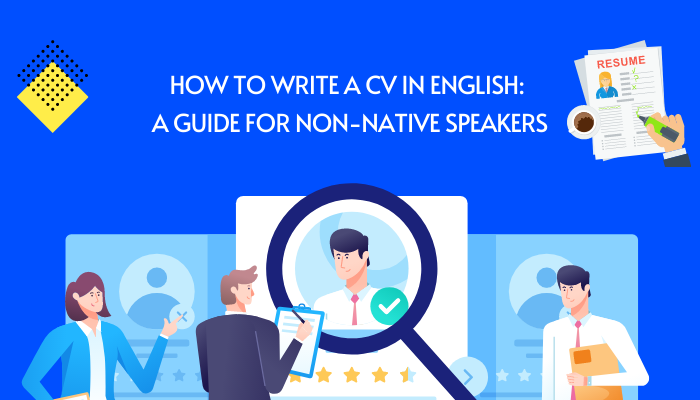


We believe that a great CV can change your life. After all, it’s the first thing that any employer will ever read about you!
This article is the ultimate guide to writing the US version of a CV. We’ve provided some expert tips, and an example to use as a template. We’ve also come up with a long list of sections you might like to include, and tips on how to format them.
What is a CV?
CV is short for “Curriculum Vitae” — a Latin phrase which roughly translates to “course of life.” It is a document that summarizes the main professional achievements of your life.
If you are applying for a job, a grant or another prestigious opportunity, you might be asked to send a CV as part of your application.
How to write a CV in English
There are no official rules for what to include in a CV. Given that they are standard documents in so many places, this is somewhat surprising! It also makes your job a little bit harder, since you must use your judgment on which sections are most relevant.
A CV should cover everything which boosts your authority in the field you are applying to. We have detailed every heading that you might need to include below. Don’t worry — you almost certainly won’t need them all. It’s a good idea to look at one or two example CVs from applicants in your field for more specific guidance. Try asking a colleague or peer if they can send you theirs.
5 Tips on writing a CV in English for non-native speakers
Most of the content of your CV will depend on what kind of opportunity you are applying to. Before we get into the fine detail, here is some general advice.
1. Customize your CV for each opportunity
A CV is a document that includes all of your achievements within a field of expertise. It takes such a long time to write that it can be tempting to recycle the same one for every opportunity.
However, every opportunity will call for candidates to show slightly different skills. It’s important to change the bullet points under your job titles or educational institutions to show why you’re the perfect candidate for this particular opportunity. For instance, if you are an artist applying for a public commission, use your bullet points to emphasize your previous works that have used public engagement. If you are an academic applying for a teaching position, write more about your teaching experiences than your research experiences.
2. Learn to use “CV speak”
Writing a CV is particularly difficult for non-native English speakers because it uses a way of writing that isn’t natural or common in any other situation. You should:
The idea is to strip your achievements down to the minimum words necessary to communicate them. If you can, rely on facts and figures to sell your achievements, rather than describing them. For instance, if you would usually describe an achievement like this:
I managed a team of fifty archeologists on an important dig just outside of the city of Rochester. We discovered the remains of a medieval city, which there had been absolutely no record of beforehand.
You might describe it like this on a CV:
Led a team of fifty archaeologists on a dig near Rochester Cathedral. Discovered previously unknown remains of a medieval city.
3. Pick a simple layout
There are plenty of CV templates available to download with beautiful design elements, elaborate borders and interesting colors. It’s best to avoid these unless you are applying for an opportunity in a visual field.
Remember the point of this document: to show your authority in the clearest way possible. Keep the design simple. It’s a power move. It shows that your professional achievements don’t need fancy packaging to seem impressive!
Use a common, easy-to-read font such as Arial or Times New Roman, and restrict the color scheme to black and white. Use enough formatting variation to mark different sections but remember that basic is best. You might simply divide passages with a line, or put headings in a slightly larger font.
4. Check it several times for consistent formatting
One of the (many) awkward things about writing a CV? There is no universal set of formatting rules, but if you do not format the document in the same way throughout, it will look very odd. For example, if you put one of your subheadings in bold, you should make sure that all of the other subheadings are in bold, too — even though there is no official rule to say you need to put all of your CV subheadings in bold!
Establishing and sticking to your own formatting rules can be tricky, so it’s a good idea to base your CV on a template, like the one included in this article. There are many small things to consider when formatting your CV consistently, but here are some to look out for:
Many people find that it’s hard to spot consistency errors in their own work. Try writing your first draft of a CV, then checking it again a day or more later, with fresh eyes. You will almost certainly see errors that you didn’t see before! Better yet, ask a friend or colleague to check it for you.
5. Have a native speaker proofread
Even if you are extremely confident in English, you should always ask a native speaker to proofread your CV. After all, the most experienced second language writer can slip up over the course of a long document!
An English native speaker will be able to help you through the odd rules of “CV speak.” They will also spot any missing determiners — those annoying little words that are difficult to use correctly every single time.
Subheadings that every CV should include
Name
Use your full name as the title of the document.
Address
On the next line down, include information that the organization needs to know to get in contact with you. At a minimum, this means listing your home address, email address and phone number. Some candidates list their Skype ID, LinkedIn page and/or personal website too.
Professional experience
In this section, give an outline of your career so far, starting with the most recent positions you’ve had. For each position, include your job title, employer, location, and the dates. Try to format this information in separate fields so it can be understood at a glance. For example:
Assistant Lecturer, History dept. Bishop’s College, London Sep 2017 – Jun 2018
You could also bullet-point your main duties under each job title. Choose bullet points related to the role you are applying to. For instance, if you are applying for a teaching position, make sure to stress your teaching experience over your research skills.
It’s a good idea to start bullet points with a past tense verb (or a present tense verb if you are describing a job role you currently hold). You should avoid using the pronoun “I,” even though this may feel a bit unnatural!
Here are some examples:
Conducted primary research using Canterbury Cathedral Archives.
Lectured to classes of over 30 students on a bi-weekly basis.
Mentored 5 third-year nursing students.
Compiled data from five years of field experiments.
Presented original research at a conference on the changing perception of women in business.
Education
Please note: if you are writing a CV for an academic position, then the section discussing your education should come before your professional experience.
List your educational background starting from your most recent achievements. If you have an MA or above, then don’t include anything less prestigious than a high school diploma. Again, you might want to list one or two bullet points about your key achievements in each educational experience. If you have an MA or PhD, then you should definitely add the title of your thesis and your supervisor. For instance:
PhD History of Art Goldsmiths College of the Arts Sep 2012- Jun 2016
Dissertation title: “The Sands of Time: 19th-century Symbolist Painters and Depictions of the British Coast throughout the Industrial Revolution”
Supervisor: Marie Arscott, History of Art Chair, Goldsmiths
Optional subheadings for CVs
Categories that make a strong CV for an artist’s grant application won’t be relevant for a CV for a postdoctoral teaching position. Choose the ones that speak to your own achievements.
Volunteer experience
For some career paths, including certain specialties in therapy, psychology and the humanitarian sector, volunteer experience is essential. If volunteer experience is important for your field, include it under a new heading on your CV.
Hobbies and interests
Some people like to include a short note on their hobbies and interests at the end of their CV. Other people feel that it detracts from the document’s professional focus. As a rule, American universities place more emphasis on “extracurriculars” than those in Europe.
It’s a matter of personal choice, but if you decide to include a section on your interests outside of work, keep it short. Like when describing your previous jobs, try to start every clause with a verb and omit the personal pronoun “I.” One example might look like this:
Swimming in the sea, longboarding, volunteering with womens’ charities, mountaineering.
Personal statement
Some people like to begin or conclude their CV with a personal statement — a few lines describing how you want to present yourself as a person. This can be a little hard for anyone to write, since it’s difficult not to sound boastful! If English is your second language, it’s probably safest to omit the “personal statement” section of a CV. However, if you feel that your CV does not capture exactly who you are, then a personal statement can be used to point to your best attributes.
As with the rest of your CV, try to avoid using any pronouns — write as though you were making notes about a very impressive colleague. Here’s an example:
A dedicated and detail-oriented researcher thoroughly committed to the study of Art History. Extensive university-level teaching experience from peer mentoring to hosting seminars, to lecturing large student cohorts. Published in several academic journals and hosted at an array of noteworthy conferences.






















